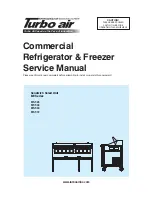
How the warning light works
The WARNING LIGHT is set to come on at
"EMERGENCY TEMPERATURE". It is this light
that observes and protects the preservation of
your frozen foods.
It FLASHES to make it more NOTICEABLE.
Its job is to warn you of a rise in
TEMPERATURE which might be caused by
one of the following:
- DOOR NOT PROPERLY CLOSED or
opened too often over a short period.
- A prolonged POWER CUT.
For PEACE OF MIND remember that your
FREEZER is designed to stand POWER
CUTS LASTING UP TO 18 HOURS before
it reaches "alarm level".
- When a CERTAIN QUANTITY of fresh food
is put in for FREEZING. In these
circumstances the flashing is short-lived
and stops once the food reaches
temperature. Frozen food already in the
freezer stays at a safe storage temperature.
- A freezer FAULT. If this is the reason the
flashing WILL GO ON. Consult the nearest
Service Centre.
In the event of PROLONGED FLASHING,
check if FOOD is STARTING TO THAW. Any
food which has started to thaw should be USED
as soon as possible; NEVER REFREEZE.
Hints for successful freezing
- Only freeze FRESH food in GOOD CONDITION.
- Make sure the food is CLEAN and either
WRAP or place in SEALED CONTAINERS,
pressing out all AIR.
- Do not freeze OVER-LARGE PORTIONS.
Each pack should be used at one go.
- Allow COOKED FOOD to cool to ROOM
TEMPERATURE before freezing.
- Place commercially FROZEN FOODS in the
freezer as soon as possible. Do not freeze
PACKS which are POORLY SEALED.
Commercially frozen prepackaged food
SHOULD BE STORED in accordance with
the manufacturers instructions for three star
frozen food storage compartments.
- NEVER exceed the STORAGE PERIODS
shown on the packs.
- Always label HOME-FROZEN foods with the
CONTENTS, FREEZING DATE AND
EXPIRY DATE.
When taking food out make sure that you
use the earliest first.
- In the event of a power cut do not open the
freezer door; a short power cut will not affect
the food inside.
- If there is a noticeable rise in the freezer
temperature (power cut, door not closed
properly, freezer failure), use the food up as
soon as possible.
- Use any THAWED food as soon as possible;
NEVER REFREEZE.
- NEVER put BOTTLES in your freezer. The
liquid will expand as it freezes, causing an
EXPLOSION.
- NEVER store CARBONATED LIQUIDS
(FIZZY DRINKS) in the freezer. This can be
dangerous.
Artificial ice blocks
This accessory is only included with certain
models, so if yours does not contain one,
disregard this section.
The artificial ice blocks prevent food from
warming-up too quickly in the event of a power
cut or failure.
They are most effective if they are placed in
the upper drawer directly on top of the
products.
The artificial ice blocks may be taken out of
the appliance and used as a practical means to
keep food temporarily cool, e.g. in an insulated
cooling bag.
Defrosting the freezer compartment
The freezer compartment needs defrosting
MANUALLY.
HOW OFTEN you need to defrost will
depend on the amount of FROST forming on
the walls. We suggest TWICE A YEAR.
To DEFROST properly:
- UNPLUG the freezer from the socket.
- Move the food to a COOL place such as the
bottom of the FRIDGE. For greater INSU-
LATION wrap food in NEWSPAPER. A
RISE in temperature of the FROZEN FOOD
PACKS during defrosting may shorten their
storage life.
- Take out the DRAWERS and wash.
- Remove the FROST from the walls. This
can be speeded up by placing a bowl of
HOT WATER in the compartment. NEVER
USE A SHARP METAL INSTRUMENT.
28
EN.qxd 02/02/05 9:15 Page 28
Summary of Contents for Refrigerator-freezer
Page 1: ......
Page 2: ......
Page 13: ...PT qxd 02 02 05 9 14 Page 12 ...
Page 23: ...PT qxd 02 02 05 9 14 Page 22 ...





































